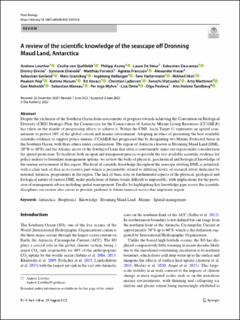A review of the scientific knowledge of the seascape off Dronning Maud Land, Antarctica
Lowther, Andrew; von Quillfeldt, Cecilie; Assmy, Philipp; de Steur, Laura; Descamps, Sebastien; Divine, Dmitry V; Elvevold, Synnøve; Forwick, Matthias; Fransson, Agneta; Fraser, Alexander; Gerland, Sebastian; Granskog, Mats A.; Hallanger, Ingeborg G.; Hattermann, Tore; Itkin, Mikhail; Hop, Haakon; Husum, Katrine; Kovacs, Kit M.; Lydersen, Christian; Matsuoka, Kenichi; Miettinen, Arto; Moholdt, Geir; Moreau, Sebastien; Myhre, Per Inge; Orme, Lisa; Pavlova, Olga; Tandberg, Anne Helene S.
Journal article, Peer reviewed
Published version

Åpne
Permanent lenke
https://hdl.handle.net/11250/3017233Utgivelsesdato
2022Metadata
Vis full innførselSamlinger
- Department of Natural History [297]
- Registrations from Cristin [9791]
Sammendrag
Despite the exclusion of the Southern Ocean from assessments of progress towards achieving the Convention on Biological Diversity (CBD) Strategic Plan, the Commission for the Conservation of Antarctic Marine Living Resources (CCAMLR) has taken on the mantle of progressing efforts to achieve it. Within the CBD, Aichi Target 11 represents an agreed commitment to protect 10% of the global coastal and marine environment. Adopting an ethos of presenting the best available scientific evidence to support policy makers, CCAMLR has progressed this by designating two Marine Protected Areas in the Southern Ocean, with three others under consideration. The region of Antarctica known as Dronning Maud Land (DML; 20°W to 40°E) and the Atlantic sector of the Southern Ocean that abuts it conveniently spans one region under consideration for spatial protection. To facilitate both an open and transparent process to provide the vest available scientific evidence for policy makers to formulate management options, we review the body of physical, geochemical and biological knowledge of the marine environment of this region. The level of scientific knowledge throughout the seascape abutting DML is polarized, with a clear lack of data in its eastern part which is presumably related to differing levels of research effort dedicated by national Antarctic programmes in the region. The lack of basic data on fundamental aspects of the physical, geological and biological nature of eastern DML make predictions of future trends difficult to impossible, with implications for the provision of management advice including spatial management. Finally, by highlighting key knowledge gaps across the scientific disciplines our review also serves to provide guidance to future research across this important region.
